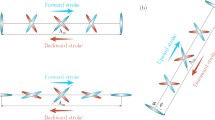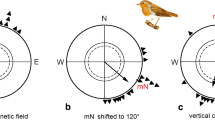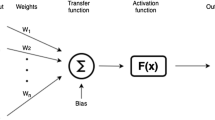Summary
-
1.
Two rules are proposed which can account for the way image motion in a horizontal plane helpsSyritta pipiens cope with disturbances during voluntary flight. The fly seems to assume that it moves within a stationary environment and that externally generated image motion is the result of some disturbance to its intended flight pattern and should be minimized.
-
2.
The first rule is concerned with the control of angular velocity. WhenSyritta cruises with no clear goal in view it keeps the angular orientation of its body constant apart from saccade-like reorientations. Thus during undisturbed flight there will be image motion all over the retina, except for regions which either look along the direction of flight or directly behind.Syritta can thus assume that any image motion over these regions (the poles of the flow field) is caused by a disturbance. Duringforward flight externally generated image motion only influences the fly's angular velocity if it occurs overfrontal retina (Fig. 6). But when the fly movessideways with respect to its long axis, so that the pole of the flow field shifts to lateral retina, image motion confined to frontal retina no longer has any effect on angular velocity (Fig. 6). It is therefore proposed that during cruising angular orientation is governed principally by image motion over the poles of the flow field.
-
3.
The second rule covers the control of translational velocity. This parameter seems to be governed by externally generated image motion over a much wider area of retina. It is proposed that each small region of retina influences a component of thrust at right angles to the direction of regard of that retinal region. The total translational response is assumed to be caused by the summed effects of image motion over many such retinal areas. Support for this rule comes from the behaviour ofSyritta when flying parallel to a vertically striped wall that moves from side to side (Fig. 7). The movement of the wall influences a component of thrust parallel to the wall, whether the fly views the wall with frontal or with lateral retina.
-
4.
It is explained how these two rules can resolve the image motion resulting from a disturbance like a gust of wind into rotational and translational components.
Similar content being viewed by others
References
Collett, T.S.: Peering — a locust behaviour pattern for obtaining motion parallax information. J. Exp. Biol.76, 237–241 (1978)
Collett, T.S., Land, M.F.: Visual control of flight behaviour in the hoverfly,Syritta pipiens L. J. Comp. Physiol.99, 1–65 (1975)
David, C.T.: Optomotor control of speed and height by free-flyingDrosophila. J. Exp. Biol.82, 389–392 (1979)
Gibson, J.J.: The ecological approach to visual perception. Boston: Houghton Mifflin 1979
Götz, K.G.: Principles of optomotor reactions in insects. Bibl. Ophthalmol.82, 251–259 (1972)
Götz, K.G.: The optomotor equilibrium of theDrosophila navigation system. J. Comp. Physiol.99, 187–210 (1975)
Heran, H.: Versuche über die Windkompensation der Bienen. Naturwissenschaften42, 132–133 (1955)
Heran, H., Lindauer, M.: Windkompensation und Seitenwindkorrektur der Bienen beim Flug über Wasser. Z. Vergl. Physiol.47, 39–55 (1963)
Holst, E. von, Mittelstaedt, H.: Das Reafferenzprinzip (Wechselwirkungen zwischen Zentralnervensystem und Peripherie). Naturwissenschaften37, 464–476 (1950)
Kalmus, H.: Optomotor responses inDrosophila andMusca. Physiol. Comp. ('s Grav.)1, 127–147 (1949)
Kalmus, H.: Animals as mathematicians. Nature (London)202, 1156–1160 (1964)
Kennedy, J.S.: The visual responses of flying mosquitoes. Proc. Zool. Soc. (London) A109, 221–242 (1940)
Lee, D.N.: Visual information during locomotion. In: Perception: essays in honor of James J. Gibson. McLeod, R.B., Pick, H.L., Jr. (eds.), pp. 250–267. Ithaca, New York: Cornell University Press 1974
Pringle, J.W.S.: Insect flight. London: Cambridge University Press 1957
Reichardt, W., Poggio, T.: Visual control of orientation behaviour in the fly. I: A quantitative analysis. Q. Rev. Biophys.9, 311–375 (1976)
Sandeman, D.C.: Regionalization in the eye of the crabLeptograpsus variegatus: Eye movements evoked by a target moving in different parts of the visual field. J. Comp. Physiol.123, 299–306 (1978)
Author information
Authors and Affiliations
Additional information
I thank Brian Cartwright, Mike Land and Jochen Zeil for their very helpful comments on the manuscript, and Sally Byatt for her flawless typing. Financial support came from the U.K. Science Research Council.
Rights and permissions
About this article
Cite this article
Collett, T.S. Some operating rules for the optomotor system of a hoverfly during voluntary flight. J. Comp. Physiol. 138, 271–282 (1980). https://doi.org/10.1007/BF00657045
Accepted:
Issue Date:
DOI: https://doi.org/10.1007/BF00657045




